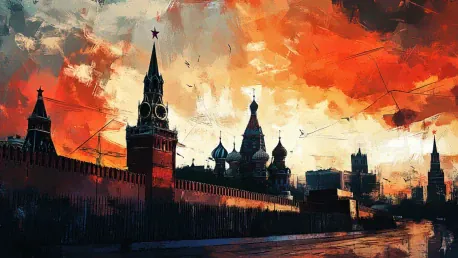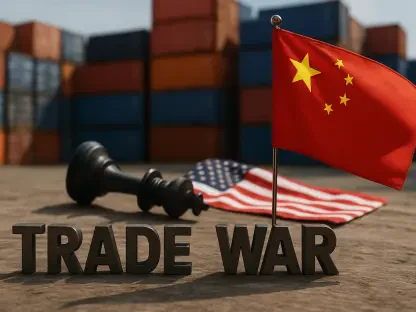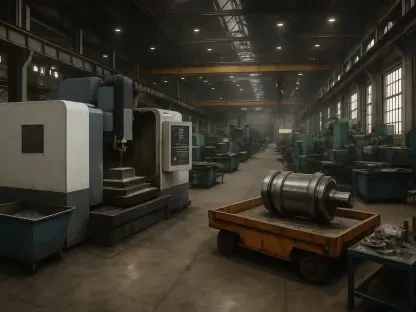Amid the Ukraine crisis and resulting Western sanctions, Russia’s economy faced significant external shocks. However, it exhibited a remarkable resilience with unexpected growth rates that surpassed those of the European Union and the United States. This article explores the factors behind Russia’s economic adaptability and future prospects.
Economic Resilience in the Face of Sanctions
Market Reforms and Crisis Management
The Russian economy’s performance amid the Ukraine crisis can be attributed to thirty years of market reforms and systematic crisis management expertise. These comprehensive reforms have laid a robust groundwork, creating an economic structure capable of absorbing shocks and bouncing back with unexpected growth. Over these three decades, key sectors of the Russian economy have undergone extensive changes, including the introduction of modern banking practices, enhanced fiscal policies, and the establishment of a market-oriented framework.
Additionally, Russia’s experience with previous economic crises has honed its crisis management capabilities. The nation has developed an adaptive approach, applying lessons learned from past downturns to navigate current challenges effectively. These include diversification of assets, strategic fiscal policies, and robust contingency planning. Government agencies, businesses, and households have all accumulated substantial knowledge in managing economic instability, contributing to an overarching resilience that enables the economy to not only weather storms but also emerge stronger.
Strategic Redirection of Trade
A critical maneuver that played a decisive role was the strategic redirection of crude oil exports from Europe to Asian markets, particularly China, India, and Türkiye. This shift has been instrumental in mitigating the effects of Western sanctions, ensuring a steady inflow of revenue despite economic pressures. The realignment of major trade partnerships has fortified Russia’s economic position, underscoring the importance of adaptability in international trade relations.
The redirection of oil exports to Asia is not only a testament to Russia’s strategic foresight but also a demonstration of its agility in response to shifting geopolitical landscapes. By pivoting towards more favorable markets, Russia has managed to sustain its oil exports, maintain crucial revenue streams, and reduce its dependency on Europe. This has also strengthened economic ties with Asian countries, opening new avenues for cooperation beyond energy, including technology, infrastructure investments, and trade in various goods and services.
Innovations and Domestic Production
Self-Sufficiency and Economic Diversification
Russia’s self-sufficiency in essential sectors such as energy, minerals, food, and water resources plays a pivotal role in maintaining a stable domestic market. This level of self-reliance has proven to be a critical asset under stringent sanctions, providing a cushion against external economic pressures. Furthermore, the diversification of the Russian economy has been a key driver of internal stability and growth, demonstrating the country’s capacity to adapt and thrive even under challenging conditions.
The strategy of economic diversification encompasses efforts to boost domestic production, reduce reliance on imports, and develop a wide range of industries from agriculture to high-tech sectors. For instance, advancements in agriculture have led to significant self-sufficiency in food production, making Russia less vulnerable to international supply chain disruptions. Moreover, the development of domestic mineral and energy reserves has not only ensured energy security but also provided export revenues that fuel further economic growth.
Technological Innovations
The resilience of Russia’s economy is further augmented by its advancements in technological innovations. From healthcare to hypersonic technologies, these innovations have fortified the economy, enabling it to withstand and adapt to external shocks. During the COVID-19 pandemic, streamlined healthcare regulations facilitated the entry of targeted therapies, particularly for autoimmune diseases, underscoring Russia’s adaptability and innovative spirit. This has not only improved public health outcomes but also reinforced economic resilience.
The adoption of cutting-edge technologies extends beyond healthcare to other critical sectors. For example, Russia has made significant strides in developing hypersonic technologies, which have important implications for national defense and technological competitiveness. Similarly, the integration of Artificial Intelligence (AI) in various industries, including finance, manufacturing, and agriculture, has driven efficiency gains and productivity improvements. The large-scale digitalization of public services has also transformed essential functions such as taxation, customs, and government administration, enhancing overall economic performance and resilience.
Strategic Economic Policies
Macro-Policy Adjustments
In response to the economic challenges, Russian macro-policy instruments have undergone significant transformation. Recently, adjustments such as relaxed budget rules and an increased fiscal impulse have stimulated demand and improved economic expectations. These changes reflect a strategic emphasis on stimulating supply growth and consolidating Russian assets within national jurisdiction. By dismantling foreign intermediaries and focusing on internal economic dynamics, Russia has crafted a unique supply-side economic model tailored to its needs.
These macro-policy adjustments are designed to create an environment conducive to sustainable economic growth. The Russian government has implemented a combination of fiscal and monetary policies aimed at stabilizing the economy while promoting investment and consumption. Relaxed budget rules, for example, have allowed for greater flexibility in government spending, fueling public investment projects that drive economic activity. Additionally, an increased fiscal impulse has supported demand stimulation, boosting consumer confidence and economic expectations. This strategic approach also involves efforts to consolidate Russian assets within the national jurisdiction, thereby protecting domestic interests and enhancing economic sovereignty.
Import Substitution and Digitalization
Despite sanctions, Russia has seen an acceleration in domestic production, particularly in agriculture, food production, and manufacturing. Import substitution has been a major focus since 2014, with substantial progress achieved in reducing dependence on foreign goods and fostering domestic capabilities. The current emphasis is shifting towards service sectors, driven by large-scale digitalization and the integration of AI. This digital transformation is enhancing efficiency across critical areas, including taxation, customs, government, and banking services, positioning Russia for future growth.
The strategy of import substitution involves developing domestic industries to replace imported goods with locally produced alternatives. This has led to significant advancements in sectors such as agriculture, where Russia has become more self-sufficient in food production. In manufacturing, efforts to produce high-quality domestic goods have reduced reliance on foreign imports, strengthening the economy’s resilience. The shift towards the service sectors, supported by digitalization and AI, is set to further enhance economic performance. By integrating digital technologies into public administration and business operations, Russia is boosting productivity, improving service delivery, and creating new opportunities for economic growth.
Labor Market and Economic Challenges
Labor Shortages and Market Constraints
Despite robust economic growth, Russia faces several challenges, including labor shortages due to full employment and restricted export markets. These issues require careful management and targeted policy interventions to ensure sustainable growth. The labor market constraints pose a significant challenge, necessitating the development of strategies to address workforce shortages and enhance productivity. Investing in education, training, and immigration policies may help mitigate these issues.
Labor shortages in Russia are partly a result of the country’s demographic trends and full employment levels. To address these constraints, the government and businesses are exploring various strategies, such as improving labor productivity, attracting foreign workers, and investing in workforce development programs. Enhancing vocational training and higher education can help equip workers with the skills needed for modern industries, thereby alleviating labor shortages. Additionally, targeted immigration policies could attract skilled workers from abroad, filling gaps in critical sectors and supporting economic growth.
Inflation and Budget Expenditures
Inflation, forecasted at 9.5 percent, and unemployment, projected to be at 2.3 percent in 2024, alongside high budget expenditures primarily driven by defense spending, present significant challenges. Managing inflation through fiscal consolidation and tighter monetary policy is crucial for stabilizing the economy. The Russian government is focusing on balancing budget expenditures while addressing price growth, aiming to create a stable economic environment conducive to long-term growth.
High budget expenditures, particularly in defense, impact the overall economic balance, requiring careful fiscal management. The government is implementing measures to ensure that spending is aligned with economic goals, avoiding excessive deficits that could undermine stability. Fiscal consolidation efforts, such as reducing unnecessary expenditures and optimizing resource allocation, are aimed at maintaining budget discipline. Tighter monetary policy, including interest rate adjustments and liquidity management, is being used to control inflation and prevent overheating of the economy. These strategies are designed to stabilize the economic environment, fostering conditions for sustainable growth.
Long-term Prospects and Global Position
Global Economic Position
The World Bank estimates place Russia among the world’s top five economies by GDP in purchasing power parity, highlighting its economic strength despite sanctions. This positioning is partly driven by the ruble’s depreciation, which has outpaced price growth and reduced the consumer basket’s equivalent dollar value. The strategic management of economic policies and international trade relations has enabled Russia to maintain a prominent position in the global economy, showcasing its resilience and adaptability.
Russia’s global economic position is a testament to its ability to navigate complex geopolitical landscapes and economic challenges. The depreciation of the ruble, while initially a challenge, has provided a competitive advantage by making Russian goods more affordable internationally. This has supported exports and enhanced the country’s trade balance. Additionally, strong fiscal and monetary policies have helped mitigate the adverse effects of sanctions, allowing Russia to retain its place among the world’s leading economies. The country’s strategic focus on developing domestic industries and fostering international trade partnerships has further solidified its global economic standing.
Strengthened Trade Alliances
In the face of the Ukraine crisis and subsequent Western sanctions, Russia’s economy encountered substantial external shocks. Surprisingly, it demonstrated impressive resilience with growth rates that outpaced those of the European Union and the United States. This resilience has piqued interest, prompting an investigation into the underlying factors that contributed to Russia’s economic adaptability and its prospects moving forward.
The sanctions were meant to cripple Russia’s economy, yet it managed to adapt and even thrive under pressure. Factors such as diversification of trade partners, domestic production boosts, and government policies aimed at economic stabilization played crucial roles. Russia’s strategic pivot towards Asia, particularly China, helped mitigate the loss of Western markets. Meanwhile, internal efforts to enhance self-sufficiency in crucial sectors, like agriculture and technology, reduced external dependencies.
Looking ahead, while challenges remain, Russia’s economy appears poised for sustained growth. Understanding the mechanisms behind its unexpected resilience could offer valuable insights for other nations facing similar adversities.









